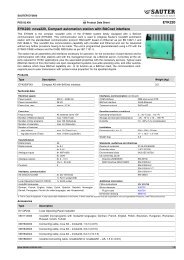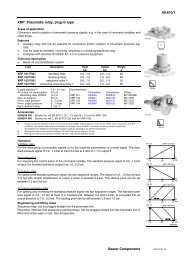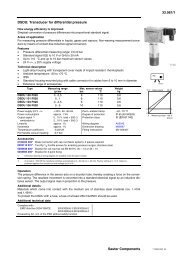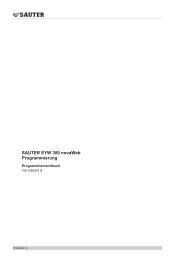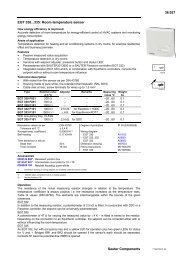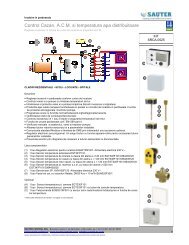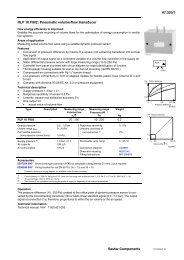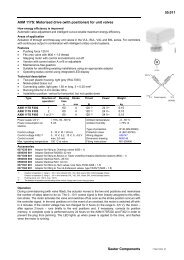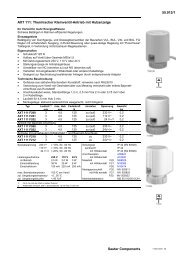EYW300 novaWeb: Configuration (7001056003)
EYW300 novaWeb: Configuration (7001056003)
EYW300 novaWeb: Configuration (7001056003)
Create successful ePaper yourself
Turn your PDF publications into a flip-book with our unique Google optimized e-Paper software.
<strong>EYW300</strong> <strong>novaWeb</strong> <strong>Configuration</strong><br />
<strong>EYW300</strong> <strong>novaWeb</strong><br />
<strong>Configuration</strong> Manual<br />
<strong>7001056003</strong> A<br />
This description corresponds to the current<br />
program release, version 2.8.3<br />
Subject to change without notice.<br />
<strong>7001056003</strong> A Sauter Systems 1
<strong>EYW300</strong> <strong>novaWeb</strong> <strong>Configuration</strong><br />
2 <strong>7001056003</strong> A Sauter Systems
<strong>EYW300</strong> <strong>novaWeb</strong> <strong>Configuration</strong><br />
Table of contents<br />
0<br />
1 Introduction...............................................................................................................5<br />
2 <strong>novaWeb</strong> documentation .........................................................................................7<br />
3 Requirements............................................................................................................9<br />
3.1 Web browser .....................................................................................................9<br />
3.1.1 FTP client ...................................................................................................9<br />
3.1.2 Tested connectivity devices (modems and router).....................................9<br />
4 Installation...............................................................................................................11<br />
4.1 Fitting...............................................................................................................11<br />
5 Housing ...................................................................................................................13<br />
6 novaNet connection ...............................................................................................15<br />
6.1 RS232 connection to novaNet291...................................................................15<br />
6.1.1 novaNet connection to automation stations .............................................15<br />
6.1.2 Manual garbage collection .......................................................................16<br />
6.1.3 AS selection .............................................................................................17<br />
6.1.4 Preferred view ..........................................................................................18<br />
7 TCP/IP connections ................................................................................................19<br />
7.1 General settings ..............................................................................................19<br />
7.1.1 Host name................................................................................................19<br />
7.1.2 DNS server...............................................................................................19<br />
7.1.3 Port numbers............................................................................................19<br />
7.2 Local connection (LAN) ...................................................................................20<br />
7.2.1 IP addressing ...........................................................................................21<br />
7.2.1.1 DHCP server in the LAN...................................................................21<br />
7.3 Remote connection (WAN)..............................................................................22<br />
7.3.1 Settings for the WAN firewall ...................................................................23<br />
7.3.2 ADSL........................................................................................................25<br />
7.3.3 Modem .....................................................................................................26<br />
7.3.3.1 Dial-in table.......................................................................................26<br />
7.3.3.2 MODEM settings...............................................................................27<br />
7.3.3.3 Dial-in................................................................................................28<br />
7.3.3.4 Dial-out .............................................................................................28<br />
7.3.3.5 Dynamic internet address .................................................................28<br />
7.3.3.6 Access via a modem portal...............................................................28<br />
8 Advanced e-mail settings ......................................................................................29<br />
8.1 Mail server .......................................................................................................29<br />
8.2 Sender .............................................................................................................29<br />
8.3 Masquerade.....................................................................................................29<br />
8.4 E-mail to SMS..................................................................................................30<br />
8.5 E-mail to WAP (e-mail to<br />
WAP gateways) ...............................................................................................30<br />
<strong>7001056003</strong> A Sauter Systems 3
0<br />
<strong>EYW300</strong> <strong>novaWeb</strong> <strong>Configuration</strong><br />
Table of contents<br />
9 Login........................................................................................................................31<br />
9.1.1 Settings and login ....................................................................................31<br />
9.1.2 User Access Levels table ........................................................................32<br />
10 Language selection................................................................................................35<br />
11 Software update .....................................................................................................37<br />
12 Back-up ...................................................................................................................39<br />
12.1 Create a back-up.............................................................................................39<br />
12.2 Restore back-up..............................................................................................40<br />
13 General security measures ...................................................................................41<br />
13.1.1 General issues.........................................................................................41<br />
13.1.2 External firewalls......................................................................................41<br />
13.1.3 Virtual private netwoks (VPN)..................................................................41<br />
14 Appendix .................................................................................................................43<br />
14.1 Modem command set......................................................................................43<br />
14.1.1 Basic Hayes command set ......................................................................43<br />
14.1.2 Extended Hayes command set................................................................45<br />
15 Abbreviations and terminology.............................................................................47<br />
4 <strong>7001056003</strong> A Sauter Systems
<strong>EYW300</strong> <strong>novaWeb</strong> <strong>Configuration</strong><br />
Introduction<br />
1<br />
1 Introduction<br />
<strong>novaWeb</strong> is an embedded web server that enables<br />
you to visualise your installation via a standard web<br />
browser. Special attention has been put on a lightweight<br />
interface (pure HTML, without ActiveX, Java<br />
etc.) to allow for fast access even with very simple<br />
devices like smartphones.<br />
According to your login level, you can visualise any<br />
states or measurements, modify setpoints and<br />
commands or modify any settings. Alarms and events (like the change of values) can be<br />
sent to up to six e-mail recipients. Furthermore, <strong>novaWeb</strong> can send out an e-mail to<br />
transfer historic values for billing or long-term storage.<br />
Thanks to the remote access facility, you can easily optimise your installation without<br />
wasting time by going to the site itself.<br />
This manual describes the user interactions via a standard web browser (Mozilla FF or<br />
MS IE) and via the standard web browser of a Symbian smartphone (SonyEricsson<br />
P910i). Since the web server is based on accepted internet standards (HTML), any web<br />
browser complying with these standards should work accordingly. Testing, however, has<br />
been limited to these programs. Since it is intended for a standard user working on a<br />
ready-configured installation, the User Manual does not describe any configuration or<br />
programming issues. For these, please refer to the appropriate manual (see also<br />
<strong>novaWeb</strong> documentation).<br />
<strong>7001056003</strong> A Sauter Systems 5
1<br />
<strong>EYW300</strong> <strong>novaWeb</strong> <strong>Configuration</strong><br />
Introduction<br />
6 <strong>7001056003</strong> A Sauter Systems
<strong>EYW300</strong> <strong>novaWeb</strong> <strong>Configuration</strong><br />
<strong>novaWeb</strong> documentation<br />
2<br />
2 <strong>novaWeb</strong> documentation<br />
According to the needs of the different users, the documentation for <strong>novaWeb</strong> has been<br />
split up into several manuals:<br />
Order<br />
Number<br />
Title<br />
Target<br />
Audience<br />
Required<br />
User Level<br />
Content<br />
7001049 User Manual End User Guest or User Standard user operations<br />
such as:<br />
Connecting to the plant<br />
<br />
<br />
Visualisation<br />
E-mail reception<br />
7001057 Quick Start<br />
Guide<br />
Project or<br />
Programming<br />
Engineer<br />
Any<br />
Basic connection set-up:<br />
Power supply,<br />
novaNet & Ethernet<br />
7001056 <strong>Configuration</strong><br />
Manual<br />
Project Engineer System<br />
Maintenance<br />
Connections:<br />
TCP/IP<br />
Dial-up<br />
Advanced features:<br />
Firewall Settings<br />
<br />
<br />
Dynamic DNS<br />
E-mail settings<br />
7001050 Programming<br />
Manual<br />
Programming<br />
Engineer<br />
(Case FBD and<br />
CASE Engine)<br />
Service<br />
Programming:<br />
Content of HTML<br />
pages<br />
<br />
Card code rules<br />
<br />
House address<br />
structure<br />
Extensions<br />
Customisation:<br />
Icons, menus,<br />
schematics etc.<br />
<strong>7001056003</strong> A Sauter Systems 7
2<br />
<strong>EYW300</strong> <strong>novaWeb</strong> <strong>Configuration</strong><br />
<strong>novaWeb</strong> documentation<br />
On top of these manuals, several other sources of information are available via the<br />
Sauter intranet:<br />
Product Data Sheet (PDS)<br />
<br />
<br />
<br />
Product Information (PI)<br />
FAQ (Frequently Asked Questions)<br />
Application Report<br />
8 <strong>7001056003</strong> A Sauter Systems
<strong>EYW300</strong> <strong>novaWeb</strong> <strong>Configuration</strong><br />
Requirements<br />
3<br />
3 Requirements<br />
3.1 Web browser<br />
A standard HTML 4.01-compliant web browser which supports frame-based pages is<br />
needed for optimal access to <strong>novaWeb</strong> pages.<br />
For standard Windows PCs, we recommend the current versions of MS IE V6.0 (or<br />
higher) or Mozilla FF V1.7 (or higher).<br />
Access via a smart phone or a PDA is also possible. Due to the relative small size of the<br />
screen of these devices, we recommend you to use a special entry page without frames<br />
or to bookmark the content page as one of your favourites (for more information, see<br />
below).<br />
For the session management, cookies must be enabled. Please refer to the user manual<br />
for more details about setting cookies, language settings and access to your site.<br />
3.1.1 FTP client<br />
A standard FTP client is needed for transferring user-specific menus and modified alarm<br />
texts to the <strong>novaWeb</strong> server. Function descriptions or pictures can also be transmitted<br />
via FTP. Even if it is possible to ftp with standard Windows tools, we recommend the<br />
use of a professional ftp client like Filezilla (http://filezilla.sourceforge.net/). Make sure<br />
the firewall is set to allow ftp communication (settings/network/firewall: basic security)<br />
and that you use passive mode.<br />
For security reasons, the FTP access is replaced by an encoded SSH access (since<br />
2.8.1). For data exchange, Filezilla can still be used, but TCP port 22 must be employed.<br />
Filezilla is freeware and can be installed as a portable application on a USB stick<br />
(http://portableapps.com).<br />
The following access data are required for the <strong>novaWeb</strong>.<br />
User name: sautersystem; password: sl@sauter.<br />
3.1.2 Tested connectivity devices (modems and router)<br />
According to the <strong>novaWeb</strong> access type, a modem or router could be necessary. We<br />
recommend the use of the following devices:<br />
Connection<br />
Analogue<br />
modem<br />
Manufacturer<br />
Website<br />
Device Connection <strong>novaWeb</strong><br />
Port<br />
Westermo www.westermo.com TDW-33 RS232 COM1<br />
ISDN ZyXel www.zyxel.com/product/index.php onmi.net Lite RS232 COM1<br />
GSM<br />
ADSL<br />
Router<br />
Sony<br />
Ericsson<br />
www.sonyericsson.com GM29 RS232 COM1<br />
ZyXel www.zyxel.com/product/index.php Prestige 650<br />
ME<br />
Ethernet<br />
LAN1<br />
<strong>7001056003</strong> A Sauter Systems 9
3<br />
<strong>EYW300</strong> <strong>novaWeb</strong> <strong>Configuration</strong><br />
Requirements<br />
10 <strong>7001056003</strong> A Sauter Systems
<strong>EYW300</strong> <strong>novaWeb</strong> <strong>Configuration</strong><br />
Installation<br />
4<br />
4 Installation<br />
You can install the <strong>novaWeb</strong> server within a cabinet or use it as a desktop device.<br />
4.1 Fitting<br />
To fit into a cabinet, use the fitting kit 0920240010 and affix the unit at the rear of the<br />
<strong>novaWeb</strong> housing.<br />
<strong>7001056003</strong> A Sauter Systems 11
4<br />
<strong>EYW300</strong> <strong>novaWeb</strong> <strong>Configuration</strong><br />
Installation<br />
12 <strong>7001056003</strong> A Sauter Systems
<strong>EYW300</strong> <strong>novaWeb</strong> <strong>Configuration</strong><br />
Housing<br />
5<br />
5 Housing<br />
The on/off switch (which lights up in blue) is on the front of the <strong>novaWeb</strong> housing.<br />
The following ports are on the rear.<br />
COM1<br />
LAN WAN Power<br />
B12092<br />
RS422<br />
RS485<br />
Modem<br />
COM2<br />
nova291<br />
Port Type Cable Connection<br />
Power<br />
Terminals<br />
plug<br />
(on power supply unit)<br />
Power supply unit*<br />
(optional)<br />
COM2, nova291<br />
DB9<br />
RS232 null modem,<br />
article no. 38630 1001<br />
novaNet 291<br />
LAN RJ 45 CAT 5 Ethernet PC or LAN<br />
WAN RJ 45 CAT 5 Ethernet PC or LAN<br />
*The external power supply unit for the <strong>novaWeb</strong> server <strong>EYW300</strong>F001B can be ordered<br />
direct from the supplier, Kabona (Sweden), using the following numner: 0920570010<br />
<strong>7001056003</strong> A Sauter Systems 13
5<br />
<strong>EYW300</strong> <strong>novaWeb</strong> <strong>Configuration</strong><br />
Housing<br />
14 <strong>7001056003</strong> A Sauter Systems
<strong>EYW300</strong> <strong>novaWeb</strong> <strong>Configuration</strong><br />
novaNet connection<br />
6<br />
6 novaNet connection<br />
6.1 RS232 connection to novaNet291<br />
For the access to the novaNet, you need a novaNet291 as a router. The novaNet291<br />
must have a recent EPROM release (at least F) and should be set to a router connection<br />
with 38400 bit/s (only switch 3 set to 'on'). The novaNet address of the novaNet291 will be<br />
set to 31777 by <strong>novaWeb</strong>, so no other PC device can use this address within the<br />
novaNet.<br />
Connect the COM2 terminal of your <strong>novaWeb</strong> device via a standard DB9 null modem<br />
cable (Sauter accessories number 386301 001) with the COM terminal of your<br />
novaNet291.<br />
6.1.1 novaNet connection to automation stations<br />
From the RJ11 or the a/b terminal of the novaNet291, use a twisted-pair cable to<br />
connect the novaNet devices (according to EY3600 automation station manual 7000968<br />
00x).<br />
<strong>7001056003</strong> A Sauter Systems 15
6<br />
<strong>EYW300</strong> <strong>novaWeb</strong> <strong>Configuration</strong><br />
novaNet connection<br />
6.1.2 Manual garbage collection<br />
Select the 'Settings' menu item in the left frame and then choose the 'Devices' item from<br />
the sub-menu in the main frame to go to the following display on the screen.<br />
After each garbage collection, <strong>novaWeb</strong> re-reads the contents of the AS. Whenever<br />
<strong>novaWeb</strong> discovers a new house address, it will add this data point to the data point<br />
database. However, it will not delete data points, since it would also lose the historic<br />
data connected to the data point, even if the data point is only temporarily unavailable.<br />
The garbage collection occurs every night (the exact time depends on the AS address),<br />
and after each complete download from the FBD; however, it can also be executed<br />
manually from CASE HWC or within the <strong>novaWeb</strong>.<br />
Please be careful with the option to do a garbage collection for all ASs (address 32000)<br />
on a large novaNet. This could lead to a rather long subscription time, especially when<br />
working simultaneously with further visualisation systems.<br />
16 <strong>7001056003</strong> A Sauter Systems
<strong>EYW300</strong> <strong>novaWeb</strong> <strong>Configuration</strong><br />
novaNet connection 6<br />
6.1.3 AS selection<br />
If only a few automation stations (e.g. out of a large novaNet) need to be treated, it is<br />
possible to specify which AS is to be visualised.<br />
Select the 'Settings' menu item in the left frame and then choose the 'Devices' item from<br />
the sub-menu in the main frame to go to the following display on the screen.<br />
In the 'AS Selection' input box, enter a station number between 0 and 31744. Intervals<br />
are written as nn-nn.<br />
Separate the stations and the intervals with commas. Leave empty if you wish to use all<br />
automation stations, e.g. 11,22,1001-1019,1033.<br />
Only the first 32 ASs of the selection will be treated. So only the ASs 0 to 31 will be<br />
visualised if you specify AS 0-100,201,202.<br />
<strong>7001056003</strong> A Sauter Systems 17
6<br />
<strong>EYW300</strong> <strong>novaWeb</strong> <strong>Configuration</strong><br />
novaNet connection<br />
6.1.4 Preferred view<br />
There is a choice of views available (since version 2.8.1):<br />
<br />
<br />
<br />
<br />
The 'classic' optimised view, which is derived from the house addresses and their<br />
extensions (name standard).<br />
The plant view is derived from the house address structure (HA structure).<br />
The station view shows the addresses sorted according to which station they are<br />
assigned (AS view).<br />
In addition, the optimum view can be chosen automatically (Auto). If, so checks<br />
are carried out in the following order:<br />
If an application module is set (MFA 63 DW 20 is 0 or 255), the plant view is<br />
derived from the house address structure (HA structure).<br />
If this is not the case, the name standard is checked next. If the planning is done<br />
according to the name standard (if, e.g. .sp "setpoint" and .ms "main sensor" of a<br />
data point are available), this view is used. If neither house address structure nor<br />
name standard is used, the stations are shown in the AS view.<br />
18 <strong>7001056003</strong> A Sauter Systems
<strong>EYW300</strong> <strong>novaWeb</strong> <strong>Configuration</strong><br />
TCP/IP connections<br />
7<br />
7 TCP/IP connections<br />
There is always a local Ethernet connection (basically for service access) and the possibility<br />
of a remote connection. The remote connection could be either an Ethernet<br />
connection (e.g. for a company LAN or an internet connection) or a dial-up connection.<br />
For convenience, the local port will be called LAN, and the remote port WAN even if this<br />
does not always fit the standard designation.<br />
Select the 'Settings' menu item in the left frame and then choose the 'Network' item from<br />
the menu in the main frame to go to the settings described in this section.<br />
7.1 General settings<br />
In all set-ups, the LAN port (indicated as LAN2 on the housing) is used as a local private<br />
network.<br />
7.1.1 Host name<br />
The host name is used for both the LAN and the WAN connections.<br />
7.1.2 DNS server<br />
The Domain Name Service (DNS) makes it possible to address devices with a name<br />
instead of a numerical IP address. The names are resolved via the so-called DNS<br />
servers. They manage and update the lists that contain the assignments of individual IP<br />
addresses to names.<br />
Scroll down the page for network settings, and you will reach the DNS server input field<br />
shown here.<br />
The IP addresses of two DNS servers can be entered. They can be located on either the<br />
local area network (LAN) or the wide area network (WAN).<br />
7.1.3 Port numbers<br />
To allow the correct service to be used for a device, it is necessary to use the correct IP<br />
address and also to address the correct port.<br />
If Hypertext Transfer Protocol (HTTP) is used, port 80 is normally used. However, it may<br />
be advisable to use a different port. If another port is to be used for <strong>novaWeb</strong>, it can be<br />
specified in the relevant field.<br />
<strong>7001056003</strong> A Sauter Systems 19
7<br />
<strong>EYW300</strong> <strong>novaWeb</strong> <strong>Configuration</strong><br />
TCP/IP connections<br />
7.2 Local connection (LAN)<br />
The <strong>novaWeb</strong> is linked to the operating computer via an Ethernet connection. The<br />
physical link to the <strong>novaWeb</strong> is made via the LAN connection, using a suitable patch<br />
cable with RJ45 plugs. The connection may be made in two ways:<br />
<br />
Via a standard Ethernet cable (patch cable) to a hub or switch. This hub or<br />
switch is then connected to the computer's Ethernet interface via an Ethernet<br />
cable.<br />
World Wide Web<br />
Alternatively:<br />
<br />
Via a crossed Ethernet cable (crossover patch cable), straight to the<br />
corresponding computer interface on the network card.<br />
The status of the network connection can be seen from the LEDs for the Ethernet<br />
interfaces:<br />
If the right-hand green LED is lit, the Ethernet connection is established. If the left-hand<br />
LED flashes yellow, this means that data are currently being transmitted (traffic).<br />
20 <strong>7001056003</strong> A Sauter Systems
<strong>EYW300</strong> <strong>novaWeb</strong> <strong>Configuration</strong><br />
TCP/IP connections 7<br />
7.2.1 IP addressing<br />
All devices within this local network (<strong>novaWeb</strong> and PCs) should be set to the same<br />
network class. This means they have the same netmask with different IP addresses<br />
within the same network class range. For example, the <strong>novaWeb</strong> could stay at<br />
10.10.10.11 and the PC could have a similar IP address like 10.10.10.10 within the<br />
same IP range (specified by the netmask).<br />
Standard private network addresses are:<br />
Network Class Start IP Address End IP Address Netmask<br />
Class A 10.0.0.0 10.255.255.255 255.0.0.0<br />
Class B 172.16.0.0 172.32.255.255 255.255.0.0<br />
Class C 192.168.0.0 192.168.255.255 255.255.255.0<br />
This is an international standard, but variations are possible. For instance, a class A IP<br />
address can also be combined with an class B or C netmask, as is done in the ex-works<br />
settings (IP address 10.10.10.11 and netmask 255.255.255.0).<br />
The <strong>novaWeb</strong> can be configured with a static IP address (see the illustration, for<br />
example) or an IP address can be assigned dynamically. For dynamic assignment of the<br />
IP address, mark DHCP in the LAN input field.<br />
7.2.1.1 DHCP server in the LAN<br />
It is also possible to let the <strong>novaWeb</strong> act as a DHCP server on LAN which automatically<br />
assigns IP addresses to any computers connected. This makes it easier for the service<br />
personnel to connect.<br />
On some installations, only Dynamic_internet_addresses can be used, which is also<br />
possible with the <strong>novaWeb</strong> but needs some extra work.<br />
Advanced_e-mail_settings are necessary if you plan to use an existing e-mail server or<br />
have other restrictions on the network for mail delivery.<br />
<strong>7001056003</strong> A Sauter Systems 21
7<br />
<strong>EYW300</strong> <strong>novaWeb</strong> <strong>Configuration</strong><br />
TCP/IP connections<br />
7.3 Remote connection (WAN)<br />
This is the alternative used when connecting to an existing LAN at the customer site or if<br />
there is a direct connection to the internet. Often, both of these apply, since the<br />
<strong>novaWeb</strong> can often access the internet through a customer's LAN.<br />
Ethernet-, driver-, Treiber-,<br />
and service und<br />
connection Service-Anschluss<br />
Kunden LAN<br />
Customer LAN<br />
oder<br />
or<br />
Internet<br />
Internet<br />
TP<br />
LAN WAN Power<br />
Modem<br />
nova291<br />
RS232<br />
serial Serielle driver<br />
Treiber<br />
B12016<br />
Network settings for WAN must be supplied by the customer or the internet supplier.<br />
Preferably, static IP addresses should be used. The IP address of the gateway has to be<br />
added for access from other networks. The DNS server provides the name resolution to<br />
IP addresses.<br />
If dynamic IP addresses are used, this IP address has to be forwarded to a dynamic<br />
name service provider (like dyndns.org or an equivalent service). In this way, it is<br />
possible to reach <strong>novaWeb</strong> via an IP name (which is assigned by the DNS server). See<br />
also Dynamic internet address.<br />
22 <strong>7001056003</strong> A Sauter Systems
<strong>EYW300</strong> <strong>novaWeb</strong> <strong>Configuration</strong><br />
TCP/IP connections 7<br />
The next illustration shows the input field for WAN settings.<br />
You can select whether not to use the WAN connection, to assign the IP addresses<br />
dynamically (mark DHCP) or to work with static IP addresses.<br />
It is also possible to implement WAN access via modem. This option is described in the<br />
modem section.<br />
The <strong>novaWeb</strong> has an integrated firewall. Follow the 'Firewall settings for WAN' link to go<br />
to the firewall configuration menu.<br />
7.3.1 Settings for the WAN firewall<br />
The settings for the WAN firewall can be found under Settings, Network (only if WAN is<br />
specified).<br />
Change firewall settings for WAN<br />
Follow this link to go to the firewall configuration menu. The following input menu<br />
appears on the screen.<br />
<strong>7001056003</strong> A Sauter Systems 23
7<br />
<strong>EYW300</strong> <strong>novaWeb</strong> <strong>Configuration</strong><br />
TCP/IP connections<br />
The firewall can be switched off, i.e. deactivated. Moreover, there are two settings for<br />
the firewall: either 'Basic' or 'High'.<br />
Depending on the selection made, the following services will pass the firewall:<br />
Transfer<br />
Service<br />
In Out Basic High<br />
Protocol<br />
dport sport dport sport<br />
Ping ICMP x -<br />
Telnet (SSH) TCP 22 1024 1024 23 x -<br />
SFTP TCP 1024,22 1024 1024 1024,22 x -<br />
HTTP TCP 80 1024 1024 80 x x<br />
SMTP TCP 1024 25 25 1024 x x<br />
DNS TCP/UDP 1024 53 53 1024 x x<br />
NTP UDP 123 123 123 123 x x<br />
DHCP UDP 67:68 67:68 67:68 67:68 x x<br />
DHCP UDP 67:68 67:68 67:68 67:68 x x<br />
All other services are rejected.<br />
If more devices are connected to the <strong>novaWeb</strong>'s LAN port, they can be addressed via<br />
the WAN port of the <strong>novaWeb</strong> (e.g. remotely via the internet). For this purpose, the<br />
relevant IP address for the device on the LAN and the associated port for<br />
communication should be entered in the table in the input field for the firewall settings.<br />
24 <strong>7001056003</strong> A Sauter Systems
<strong>EYW300</strong> <strong>novaWeb</strong> <strong>Configuration</strong><br />
TCP/IP connections 7<br />
7.3.2 ADSL<br />
Regarding the configuration of the network settings page, this is identical to a WAN<br />
setting. In the easiest case, you get a static IP address (as well as a DNS name) which<br />
you specify in the network settings page. If you use dynamic IP addresses, this IP<br />
address has to be forwarded to a dynamic host name service which updates its DNS<br />
records (assignment of host names to IP addresses). This forwarding of the correct IP<br />
address must be handled via the ADSL device (ADSL router).<br />
Ethernet-, driver-, Treiber-,<br />
and service und<br />
connection<br />
Service-Anschluss<br />
ADSL<br />
Internet<br />
TP<br />
TP<br />
ADSL Router<br />
LAN WAN Power<br />
Modem<br />
nova291<br />
RS232<br />
Serial Serielle driver<br />
Treiber<br />
B12017<br />
<strong>7001056003</strong> A Sauter Systems 25
7<br />
<strong>EYW300</strong> <strong>novaWeb</strong> <strong>Configuration</strong><br />
TCP/IP connections<br />
7.3.3 Modem<br />
It is also possible to use a dial-up/dial-in connection instead of a WAN. If <strong>novaWeb</strong><br />
sends out any messages (alarms or DAQ), it uses the dial-up connection to forward this<br />
message to an SMTP (e-mail) server (usually on the internet). When you want to<br />
connect to <strong>novaWeb</strong>, you open a dial-in connection (usually direct, modem to modem).<br />
Ethernet-, controllers driver-,<br />
and service and<br />
connection service connection<br />
TP<br />
LAN WAN Power<br />
Modem<br />
nova291<br />
TP<br />
RS232<br />
POTS / ISDN /<br />
GSM Modem<br />
Dial up Internet<br />
Dial in access<br />
Serial Serial driver<br />
controllers<br />
B12017<br />
In general, it should be possible to use any Hayes-compatible modem. Testing,<br />
however, has been limited to the above-mentioned modems.<br />
The connection type could either be POTS (Plain Old Telephone Services), ISDN or<br />
GSM.<br />
7.3.3.1 Dial-in table<br />
<strong>novaWeb</strong> modem<br />
Browsing device Connection Type POTS ISDN GSM<br />
Smartphone (e.g. P10i) GSM x x x<br />
PC<br />
POTS x - x<br />
ISDN x x x<br />
GSM x x x<br />
26 <strong>7001056003</strong> A Sauter Systems
<strong>EYW300</strong> <strong>novaWeb</strong> <strong>Configuration</strong><br />
TCP/IP connections 7<br />
7.3.3.2 MODEM settings<br />
Name Value Description<br />
Baud rate 57600 Ex. 19200<br />
Dial number 0616831830 Ex.033101112 , 0w033101112<br />
Username<br />
From internet operator<br />
Password<br />
From internet operator<br />
Timeout 300 in seconds without traffic before hang-up. Ex. 300<br />
Init 1 ATQ0V1H0 AT command 1. Ex. ATQ0V1H0<br />
Init 2 ATS0=0&D3&C1 AT command 2. Ex. ATS0=0&D3&C1<br />
Init 3<br />
AT command 3. Ex. AT+CXXSN=2\\\N6<br />
There are three init strings available to configure the modem for the correct behaviour.<br />
Normally, the AT commands Q0 V1 H0 S0=0 &D3 &C1 or equivalent must be configured<br />
for correct operation.<br />
N.B.: To send the character \ to the modem, enter \\\ due to character handling in the<br />
web server and Linux.<br />
AT<br />
Attention<br />
Q Quiet Mode Q0 Quiet Mode Off<br />
V Verbose V1 English result codes<br />
H Hook Status H0 On hook Hang up<br />
Sn=r<br />
&D<br />
Store the<br />
value of r in<br />
S-register n<br />
Data Terminal<br />
Ready (DTR)<br />
Display result codes, user<br />
sees command<br />
responses (e.g.OK)<br />
e.g.CONNECT, BUSY,<br />
NO CARRIER etc.<br />
S0=0 Set register 0 to 0 Do not accept dial-in<br />
S0=1 Set register 0 to 1 (or 2 or 3)<br />
&D3<br />
&D0<br />
Hang up, reset the modem,<br />
and return to command<br />
mode upon DTR<br />
Signal ignored<br />
Pick up the receiver after<br />
first (1) ring<br />
This is needed for the SE<br />
GSM modem (see your<br />
manual for more<br />
information)<br />
&C Carrier detect &C1 Indicates remote carrier Usual preferred default<br />
<strong>7001056003</strong> A Sauter Systems 27
7<br />
<strong>EYW300</strong> <strong>novaWeb</strong> <strong>Configuration</strong><br />
TCP/IP connections<br />
7.3.3.3 Dial-in<br />
As soon as the modem is configured to accept incoming calls (S0=1), it is possible to<br />
connect to <strong>novaWeb</strong>'s dial-in support. Both terminal (e.g. via HyperTerminal) and PPP<br />
(HTML browser) are supported.<br />
Use the following when connecting using PPP to <strong>novaWeb</strong>:<br />
<br />
<br />
Username: cpp<br />
Password: blixten<br />
N.B.: For a more detailed description of dial-in, see the operating instructions, 15.4.2.<br />
7.3.3.4 Dial-out<br />
If Dial number, Username and Password are entered, the dial-out connection is<br />
activated used for alarm and DAQ sending purposes.<br />
The connection will use 'dial on demand' and will hang up after time-out seconds without<br />
traffic.<br />
7.3.3.5 Dynamic internet address<br />
In some cases, it is not possible to get a static internet address, since the operator offers<br />
only dynamic addresses through DHCP. The problem with a dynamic address is how to<br />
know what the current address is so that you can connect to <strong>novaWeb</strong>'s web server. A<br />
number of companies, such as dyndns.org, offer a solution to this problem by providing<br />
a dynamic DNS service. This is done by registering a sub-domain such as<br />
wdc.dyndns.org and then using a special client application to inform the dynamic DNS<br />
which address is currently assigned to the <strong>novaWeb</strong> by the operator.<br />
To periodically check and update the current address, an ADSL router with this<br />
functionality is normally used.<br />
7.3.3.6 Access via a modem portal<br />
If you do not want the <strong>novaWeb</strong> to be connected to the internet constantly but you still wish<br />
to access via the internet, you can use a Modem Portal Service.<br />
Modem Portal Services provide access to the web server over the telephone network. An<br />
internet connection is established as soon as a user wants to access a web page.<br />
For further details, search the internet for modem portal providers (e.g. www.emazy.com).<br />
28 <strong>7001056003</strong> A Sauter Systems
<strong>EYW300</strong> <strong>novaWeb</strong> <strong>Configuration</strong><br />
Advanced e-mail settings<br />
8<br />
8 Advanced e-mail settings<br />
Through the 'Settings' menu item in the left-hand frame and then the 'Network' menu<br />
item in the main frame, you come to the page that also contains the 'Advanced e-mail<br />
settings'. If you scroll down, you reach the following input field.<br />
Sender<br />
Mail server<br />
Ex. <strong>novaWeb</strong>@sauter-bc.com<br />
Ex. smtp.customer.dom<br />
Masquerade Ex. 10.11.12.13<br />
N.B.: No support is provided for SMTP servers which need no authentication.<br />
The following sections describe the settings that can be made.<br />
8.1 Mail server<br />
<strong>novaWeb</strong> runs an embedded mail transfer agent. Therefore, no external server is<br />
needed to send the e-mails. The e-mail server of the recipient will be discovered via a<br />
DNS request: "Who handles e-mail to xyz".<br />
In some configurations, however, it is desirable to use an existing mail server on the<br />
customer's LAN which handles all deliveries on behalf of <strong>novaWeb</strong>. This might be the<br />
case due to firewall configurations.<br />
If you specified the host name with domain name (e.g. embweb02.ch.sauter-bc.com),<br />
then you can specify an e-mail server without a domain name (e.g. only imap instead of<br />
imap.ch.sauter-bc.com).<br />
8.2 Sender<br />
Normally, mail servers do not forward e-mail for unknown users. Therefore, a user id<br />
should be specified when sending e-mail. Furthermore, if the recipient cannot be<br />
reached, the message will be returned to the sender. To make sure that no messages<br />
are lost, you should enter your mail address if you want to be informed of any<br />
unreachable recipients.<br />
8.3 Masquerade<br />
Masquerading is needed only if you have firewalls with such rules as "Accept e-mail only<br />
from IP x.x.x.x".<br />
<strong>7001056003</strong> A Sauter Systems 29
8<br />
<strong>EYW300</strong> <strong>novaWeb</strong> <strong>Configuration</strong><br />
Advanced e-mail settings<br />
8.4 E-mail to SMS<br />
<strong>novaWeb</strong> sends out e-mails only. If you need further services, such as SMS messages,<br />
we recommend that you use a Unified Messaging Provider such as www.ecall.ch or<br />
teammessage.de.<br />
Another possibility is to use a GSM Service Provider, such as Swisscom or Vodafone.<br />
Most mobile phones automatically allow you to send and receive SMS messages. If the<br />
Short Message Service (SMS) is not already programmed on your mobile phone, then<br />
you usually need to enter and store the number of the service provider (e.g. the<br />
Swisscom Mobile SMS exchange: +41 79 499 90 00). To find out how this functions with<br />
your particular mobile phone, please consult the user manual applicable to your model<br />
8.5 E-mail to WAP (e-mail to<br />
WAP gateways)<br />
With certain e-mail providers, such as arcor, yahoo, web.de, freenet.de or epost, it is<br />
possible to access your e-mail account via a WAP page. Other gateway services like<br />
ZWAP (www.zwap.de) allow for provider-independent WAP access to (POP3) e-mail<br />
accounts. This could be useful if your mobile phone cannot access a normal e-mail<br />
(POP3 or IMAP) account.<br />
30 <strong>7001056003</strong> A Sauter Systems
<strong>EYW300</strong> <strong>novaWeb</strong> <strong>Configuration</strong><br />
Login<br />
9<br />
9 Login<br />
Within the login settings page, you can specify the passwords for the different user<br />
levels.<br />
To reach this page, first call up the 'Settings' menu item in the left frame, and then select<br />
the 'Log-In' menu item in the main frame. You see the following page.<br />
In general, the access to the <strong>novaWeb</strong> pages is controlled only by the user level and the<br />
relevant password. The user name can be chosen freely.<br />
The guest login can be allowed or blocked.<br />
A new user password can be added in the last line.<br />
9.1.1 Settings and login<br />
For the various areas, the default settings for the password are as follows:-<br />
User: user@sauter<br />
Service: service@sauter<br />
System Wartung: ml@sauter<br />
You are strongly advised to change the passwords; only then is the system protected<br />
against unauthorised access.<br />
<strong>7001056003</strong> A Sauter Systems 31
9<br />
<strong>EYW300</strong> <strong>novaWeb</strong> <strong>Configuration</strong><br />
Login<br />
9.1.2 User Access Levels table<br />
The illustrated data points and the possible functions according to the different user<br />
levels can be seen in the following table:<br />
Main<br />
Pages<br />
Regul<br />
ations<br />
Install<br />
ations<br />
Alarm<br />
s<br />
Pages Actions Data<br />
points<br />
Regulation<br />
s Overview<br />
System<br />
View<br />
Functional<br />
Description<br />
Guest<br />
Us<br />
er<br />
User Access Level<br />
Service<br />
System<br />
Maintenance<br />
Display x x x x<br />
Changing<br />
setpoints<br />
sp - x x x<br />
Display x x x x<br />
History x x x x<br />
Changing time<br />
schedule<br />
Changing<br />
setpoints<br />
Switching<br />
commands<br />
Push-button<br />
commands<br />
Reset<br />
counters<br />
Modification of<br />
compensation<br />
curve<br />
tc - x x x<br />
sp - x x x<br />
sw - x x x<br />
pb - x x x<br />
met.pb? - - x x<br />
x1..x6,<br />
y1..y6,<br />
eco<br />
- x x x<br />
Display - x x x x<br />
Schematic Display - x x x x<br />
Service<br />
View<br />
System<br />
Maintenanc<br />
e View<br />
Display - - x x<br />
mn, mx<br />
Display - - - x<br />
Display x x x x<br />
Acknowledging<br />
alarms<br />
al - x x x<br />
Event Pages 1 to Display x x x x<br />
32 <strong>7001056003</strong> A Sauter Systems
<strong>EYW300</strong> <strong>novaWeb</strong> <strong>Configuration</strong><br />
Login 9<br />
Main<br />
Pages<br />
s 4<br />
Servic<br />
e<br />
Pages Actions Data<br />
points<br />
Guest<br />
Us<br />
er<br />
User Access Level<br />
Service<br />
System<br />
Maintenance<br />
Adding events - x x x<br />
AS Display X x x x<br />
History<br />
Settin<br />
gs<br />
Alarms<br />
Data<br />
Acquisition<br />
System<br />
maintenance<br />
Time<br />
Values<br />
Changing<br />
setpoints<br />
Changing<br />
recipients<br />
Changing<br />
schedules<br />
sp - - x x<br />
- - x x<br />
- - x x<br />
Display - x x x<br />
Display and<br />
download values<br />
Changing<br />
recipients<br />
Changing<br />
system name,<br />
download HTML,<br />
download versions<br />
upgrade,<br />
re-start/stop/reboot<br />
the system<br />
Selecting<br />
network clock<br />
Setting time<br />
manually<br />
Save and restore<br />
settings; backup<br />
functions<br />
- x x x<br />
- - x x<br />
- - x x<br />
- - x x<br />
- - x x<br />
- - x x<br />
<strong>7001056003</strong> A Sauter Systems 33
9<br />
<strong>EYW300</strong> <strong>novaWeb</strong> <strong>Configuration</strong><br />
Login<br />
Devices<br />
Login<br />
Network<br />
Language<br />
Service devices;<br />
Perform memory<br />
clean; preferred<br />
view; select AS<br />
Modifying user<br />
and passwords<br />
Modifying<br />
network<br />
settings<br />
Selecting<br />
language (for<br />
HTML pages)<br />
- - only link x<br />
- - - x<br />
- - - x<br />
- - - x<br />
34 <strong>7001056003</strong> A Sauter Systems
<strong>EYW300</strong> <strong>novaWeb</strong> <strong>Configuration</strong><br />
Language selection<br />
10<br />
10 Language selection<br />
Depending on the language specification file (lang.csv), it is possible to select between<br />
four different languages.<br />
To view the page for the language settings, first select the 'Settings' menu item in the left<br />
frame and then select the 'Language' menu item in the main frame.<br />
If your preferred language is not included, please check with your local support for the<br />
availability of a customised version.<br />
After switching the language, some frames have to be reloaded manually. Some buttons<br />
will appear properly only after <strong>novaWeb</strong> has been rebooted.<br />
<strong>7001056003</strong> A Sauter Systems 35
10<br />
<strong>EYW300</strong> <strong>novaWeb</strong> <strong>Configuration</strong><br />
Language selection<br />
36 <strong>7001056003</strong> A Sauter Systems
<strong>EYW300</strong> <strong>novaWeb</strong> <strong>Configuration</strong><br />
Software update 11<br />
11 Software update<br />
Call up the 'Settings' link in the navigation window, then the 'System maintenance' link in<br />
the main window.<br />
Now you can download the latest software version for the <strong>novaWeb</strong>. Contact your local<br />
customer service to obtain the file representing the latest software version.<br />
<strong>7001056003</strong> A Sauter Systems 37
11<br />
<strong>EYW300</strong> <strong>novaWeb</strong> <strong>Configuration</strong><br />
Software update<br />
38 <strong>7001056003</strong> A Sauter Systems
<strong>EYW300</strong> <strong>novaWeb</strong> <strong>Configuration</strong><br />
Back-up<br />
12<br />
12 Back-up<br />
12.1 Create a back-up<br />
<br />
<br />
<br />
In the 'Values' tab, click 'Back-up settings'.<br />
The 'File download' menu then opens.<br />
Click 'Save' in the 'File download' menu.<br />
<strong>7001056003</strong> A Sauter Systems 39
12<br />
<strong>EYW300</strong> <strong>novaWeb</strong> <strong>Configuration</strong><br />
Back-up<br />
12.2 Restore back-up<br />
A back-up is stored as a .tgz file, but a .tar file is needed for a restore, so take the<br />
following steps in order to convert the .tgz file into a .tar file.<br />
<br />
<br />
<br />
<br />
Open the .tgz file using Winzip.<br />
Answer the question "Should WinZip decompress…" with 'NO'.<br />
Drag and drop the .tar file to a place of your choice.<br />
Carry out a restore with the created .tar file using 'Restore settings'.<br />
40 <strong>7001056003</strong> A Sauter Systems
<strong>EYW300</strong> <strong>novaWeb</strong> <strong>Configuration</strong><br />
General security measures<br />
13<br />
13 General security measures<br />
Depending on the importance of the monitored site (from simple 'heating' to 'danger to<br />
life'), security needs can vary tremendously. Please discuss your specific security needs<br />
with an IT professional. He will advise you on password management (regular change<br />
etc.), firewalls and other security measures.<br />
13.1.1 General issues<br />
In general, you should be aware of the following issues when making any decision<br />
regarding your network configuration:<br />
Confidentiality, Privacy<br />
<br />
<br />
<br />
<br />
<br />
Integrity<br />
Authentication<br />
Authorisation<br />
Non-Repudiation<br />
Availability, Access<br />
13.1.2 External firewalls<br />
Even with the included firewall, you should take extra care when connecting to the<br />
internet. A standard internet server is always protected by an external firewall. This<br />
could be included in the access router (e.g. ADSL router) or a whole demilitarised zone<br />
is set up.<br />
13.1.3 Virtual private netwoks (VPN)<br />
If access to <strong>novaWeb</strong> is needed only from certain places, a virtual private network (VPN)<br />
can be set up. There are a lot of different set-ups, but, in general, a VPN server provides<br />
an access point for a VPN client to connect via an IPSec (or PPTP or SSL) connection<br />
to a LAN site (e.g. the <strong>novaWeb</strong> installation). Please check with your IT professional for<br />
more details.<br />
<strong>7001056003</strong> A Sauter Systems 41
13<br />
<strong>EYW300</strong> <strong>novaWeb</strong> <strong>Configuration</strong><br />
General security measures<br />
42 <strong>7001056003</strong> A Sauter Systems
<strong>EYW300</strong> <strong>novaWeb</strong> <strong>Configuration</strong><br />
Appendix<br />
14<br />
14 Appendix<br />
14.1 Modem command set<br />
14.1.1 Basic Hayes command set<br />
Command Description Comments<br />
A0 or A Answer incoming call<br />
A/ Repeat last command Do not preface with AT. Enter usually aborts.<br />
B0 or B Call negotiation V32 Mode/CCITT Answer Seq.<br />
B1 Call negotiation Bell 212A Answer Seq.<br />
B2 Call negotiation Verbose/Quiet On Answer<br />
D<br />
Dial<br />
Dial the following number and then handshake in<br />
originate mode.<br />
P<br />
Pulse Dial<br />
T<br />
Touch Tone Dial<br />
W<br />
Wait for the second dial tone<br />
,<br />
Pause for the time specified in register S8<br />
(usually 2 seconds<br />
;<br />
Remain in command mode after dialling.<br />
!<br />
Flash button telephone receiver (hang up<br />
for a half second, as in transferring a call.<br />
L<br />
Dial last number<br />
E0 or E No echo Will not echo commands to the computer<br />
E1 Echo<br />
Will echo commands to the computer (so one can<br />
see what one types)<br />
H0 Hook status On hook: hang up<br />
H1 Hook status Off hook: phone picked up<br />
I0 or I<br />
Inquiry, information or<br />
interrogation<br />
This command is very model-specific. I0 usually<br />
returns a number or code, while higher numbers<br />
often provide much more useful information.<br />
<strong>7001056003</strong> A Sauter Systems 43
14<br />
<strong>EYW300</strong> <strong>novaWeb</strong> <strong>Configuration</strong><br />
Appendix<br />
Command Description Comments<br />
Speaker loudness.<br />
L0 or L<br />
Modems with volume control<br />
Off or low volume<br />
knobs will not have these<br />
options.<br />
L1<br />
Low volume<br />
L2<br />
Medium volume<br />
L3<br />
Loud or high volume<br />
M0 or M Speaker off M3 is also common, but different on many brands<br />
M1<br />
Speaker on until remote carrier detected<br />
(i.e. until the other modem is heard)<br />
M2<br />
Speaker is always on (data sounds are heard after<br />
CONNECT)<br />
N0 or N Handshake speed Handshake only at speed in S37<br />
N1<br />
Handshake at highest speed greater than S37<br />
O0 or O Return online See also X1 as dial tone detection may be active.<br />
O1<br />
Return online after an equaliser retrain sequence<br />
Q0 or Q1 Quiet mode<br />
Off: displays result codes, user sees command<br />
responses (e.g.OK)<br />
Q1 Quiet mode<br />
On: result codes are suppressed, user does not<br />
see responses.<br />
Sn?<br />
Query the contents of S-register n<br />
Sn=r Store Store the value of r in S-register n<br />
V0 or V Verbose Numeric result codes<br />
V1<br />
English result codes (e.g. CONNECT, BUSY,<br />
NO CARRIER etc.)<br />
X0 or X Smartmodem Hayes Smartmodem 300 compatible result codes<br />
X1<br />
Usually adds connection speed to basic result<br />
codes (e.g.CONNECT 1200<br />
X2<br />
Usually adds dial tone detection (preventing blind<br />
dial, and sometimes preventing AT0)<br />
X3<br />
Usually adds busy signal detection<br />
X4<br />
Usually adds both busy signal and dial tone<br />
detection<br />
Z0 or Z Reset<br />
Reset modem to stored configuration. Use Z0, Z1<br />
etc. for multiple profiles. This is the same as &F for<br />
factory default on modems without NVRAM (nonvolatile<br />
memory)<br />
44 <strong>7001056003</strong> A Sauter Systems
<strong>EYW300</strong> <strong>novaWeb</strong> <strong>Configuration</strong><br />
Appendix 14<br />
14.1.2 Extended Hayes command set<br />
Command Description Comments<br />
&B0 or &B Retrain parameters Disable auto retrain function<br />
&B1 Retrain parameters Enable auto retrain function<br />
&B2<br />
Retrain parameters<br />
Enable auto retrain, but disconnect if no line<br />
improvement over the period dictated by S7<br />
&C0 or &C1 Carrier detect Signal always on<br />
&C1<br />
Carrier detect<br />
Indicates remote carrier (usual preferred<br />
default)<br />
&D0 or &D Data Terminal Ready (DTR<br />
Signal ignored (this is modem-specific, so<br />
refer to your manual)<br />
&D1<br />
Data Terminal Ready (DTR<br />
If DTR goes from On to Off, the modem<br />
goes into command mode (some modems<br />
only)<br />
&D2<br />
Data Terminal Ready (DTR<br />
Some modems hang up on DTR transition<br />
from On to Off (this is the usual preferred<br />
default)<br />
&D3<br />
Data Terminal Ready (DTR<br />
Hang up, reset the modem, and return to<br />
command mode upon DTR<br />
Generic Hayes-compatible defaults.<br />
&F0 or &F<br />
Factory defaults<br />
This is usually a good thing to use in your<br />
init string, since the &F1-&F3 settings can<br />
vary among modems, and they may<br />
actually be the cause of connection<br />
problems (since you never know exactly<br />
what Brand X's &F2 really changes).<br />
On the other hand, it pays to try out the<br />
other options below; many people's<br />
problems can be solved by replacing a<br />
complicated init string with a simple &F2 or<br />
the like. However, if you're building an init<br />
string, it is best to start with a simple &F,<br />
and not use the ‘customised’ form of<br />
defaults.<br />
&F1<br />
Factory defaults<br />
Factory defaults tailored to an IBM PCcompatible<br />
user<br />
&F2<br />
Factory defaults<br />
Factory defaults for a Mac with software<br />
handshaking<br />
&F3<br />
Factory defaults<br />
Factory defaults for a Mac with hardware<br />
handshaking<br />
&G0 or &G Guard tones Disable guard tones<br />
&K0 or &K Local flow control Disable local flow control<br />
&K1 Local flow control Enable RTS/CTS hardware local flow<br />
<strong>7001056003</strong> A Sauter Systems 45
14<br />
<strong>EYW300</strong> <strong>novaWeb</strong> <strong>Configuration</strong><br />
Appendix<br />
Command Description Comments<br />
control<br />
&K2<br />
Local flow control<br />
Enable XON/XOFF software local flow<br />
control<br />
&K3<br />
Local flow control<br />
Enable RTS/CTS hardware local flow<br />
control<br />
&K4<br />
Local flow control<br />
Enable XON/XOFF software local flow<br />
control<br />
&L0 or &L Dial mode Select dial-up mode<br />
&M0 or &M Error control mode<br />
Select asynchronous non-EC mode (the<br />
same as &Q0)<br />
&P0 or &P Pulse dialling ratio<br />
U.S./Canada pulse dialling 39% make/61%<br />
break ratio<br />
&P1<br />
Pulse dialling ratio<br />
U.K./Hong Kong pulse dialling 33%<br />
make/67% break ratio<br />
&Q0 or &Q Error control mode<br />
Asynchronous non-EC mode. No data<br />
buffering. ASB disabled.<br />
&Q5<br />
Error control mode<br />
Select V.42 EC operation (requires flow<br />
control)<br />
&Q6<br />
Error control mode<br />
Asynchronous mode with ASB (requires<br />
flow control)<br />
&Q8 Error control mode Select alternate EC protocol (MNP)<br />
&Q9<br />
Error control mode<br />
Conditional data compression: V.42bis =<br />
yes, MNP5 = no.<br />
&S0 or &S DSR action select Always on (default)<br />
&S1<br />
DSR action select<br />
Follows EIA specification (active following<br />
carrier tone, and until carrier is lost)<br />
&T0 or &T Self-test Model-specific self-test on some modems<br />
&U0 or &U Trellis code modulation Enable V.32 TCM<br />
&U1 Trellis code modulation Disable V.32 TCM<br />
&V0 or &V1 View active<br />
View (oft-stored) configuration profile<br />
settings (or ATI4)<br />
&W0 or &W Store profile<br />
In NVRAM (&W0, &W1 etc. for multiple<br />
profiles), some settings cannot be stored.<br />
These often do not show on &V or ATI4.<br />
&Y0 or &Y<br />
Select configuration loaded<br />
at power-up<br />
Load profile 0 (default)<br />
&Y1<br />
Select configuration loaded<br />
at power-up<br />
Load profile 1<br />
&Zn=x<br />
Soft reset and load stored<br />
profile number n<br />
Note that all items after the &Z on the<br />
command line are ignored<br />
46 <strong>7001056003</strong> A Sauter Systems
<strong>EYW300</strong> <strong>novaWeb</strong> <strong>Configuration</strong><br />
Abbreviations and terminology<br />
15<br />
15 Abbreviations and terminology<br />
ActiveX<br />
Microsoft technology for software components which can be used by other<br />
programs.<br />
AS<br />
Automation stations or controllers are autonomous automation devices for the<br />
control of heating, air-conditioning or other systems in buildings.<br />
Cache<br />
A local copy of data which have been fetched from a remote host to reduce<br />
access time.<br />
Cookie<br />
A cookie is a piece of information sent by the web server to the client, e.g. for<br />
identification purposes (session management).<br />
CSD<br />
Circuit Switched Data is the standard type of transmission for GSM with 14.4<br />
kBit/s, which is traditionally used for voice transmission.<br />
CSV<br />
Comma-Separated Variables is a tabular data format which uses delimiters<br />
(commas, tabs, semicolons etc.) to separate fields.<br />
DNS<br />
In a Domain Name System, one or more servers store and provide information<br />
such as the IP addresses of each host and the mail exchange servers.<br />
FF<br />
Mozilla Firefox<br />
GMT<br />
Greenwich Mean Time is the time at 0 degrees geographic longitude (at<br />
Greenwich near London, UK). International time stamps are normally indicated<br />
as offset to GMT.<br />
GPRS<br />
General Packet Radio Service is a packet-switched data transmission which is<br />
also much faster than CSD (also up to 56 kBit/s). However, the connection is (in<br />
theory) always established, but you pay only for the actual data volume.<br />
GSM<br />
Global System for Mobile Communication is a worldwide standard for mobile<br />
phones.<br />
HSCSD<br />
High-Speed CSD bundles several CSD transmission channels together to allow<br />
higher transmission rates (normally up to 56 kBit/s).<br />
HTML<br />
HyperText Mark-up Language is a language for web pages (links are marked<br />
up).<br />
HTTP<br />
HyperText Transfer Protocol is the protocol used to transfer HTML-based web<br />
pages over a TCP/IP connection.<br />
IE<br />
Microsoft Internet Explorer<br />
<strong>7001056003</strong> A Sauter Systems 47
15<br />
<strong>EYW300</strong> <strong>novaWeb</strong> <strong>Configuration</strong><br />
Abbreviations and terminology<br />
IP<br />
Internet Protocol is the standard network layer protocol for network<br />
communication.<br />
ISDN<br />
Integrated Services Digital Network is a standard for digital telephone<br />
communication.<br />
ISO<br />
International Organisation for Standardisation is an international nongovernmental<br />
standard-setting organisation.<br />
IT<br />
Information Technology<br />
Java<br />
Object-orientated programming language developed by Sun.<br />
JavaScript<br />
Object-orientated scripting language developed by Netscape.<br />
MFA<br />
Data point address within an AS.<br />
MS<br />
Microsoft<br />
PDA<br />
Personal Digital Assistants are hand-held devices which usually include an<br />
organiser, some viewers and further programs.<br />
RAM<br />
Random access memory is the memory used to store the program and data<br />
during execution (as long as the device is running).<br />
RT<br />
Real-Time Clock<br />
SIM<br />
Subscriber Identity Module is a card in which a key is stored to identify a mobile<br />
phone (GSM) subscriber.<br />
Smartphone<br />
Smartphones are hand-held devices which combine the functions of PDAs and<br />
mobile phones.<br />
For more information, refer to web-based encyclopaedias such as Wikipedia.<br />
© 2003 by Sauter AG, Im Surinam 55, CH-4016 Basle, Switzerland<br />
48 <strong>7001056003</strong> A Sauter Systems



